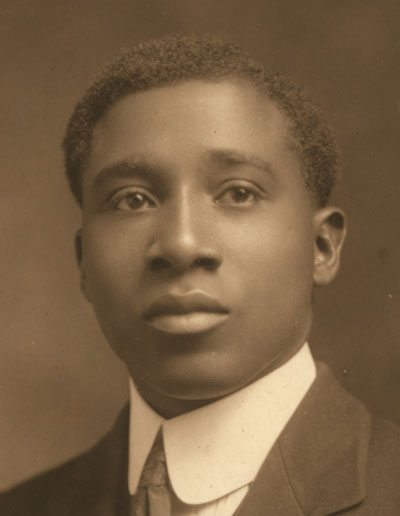R. Nathaniel Dett

- Born: October 11, 1882, Niagara Falls, Canada
- Died: October 2, 1943, Battle Creek, Michigan
The Ordering of Moses
- Composed: 1932
- Premiere: Premiered on May 7, 1937 at the Cincinnati May Festival, conducted by Eugene Goossens with soprano Agatha Lewis, contralto Elizabeth Wysor, tenor Frederick Jagel and baritone Alexander Kisselburgh as soloists.
- Instrumentation: SATB soloists, SATB chorus, 2 flutes, piccolo, 2 oboes, 2 clarinets, 2 bassoons, 4 horns, 2 trumpets, 3 trombones, tuba, timpani, bass drum, castanets, chains, crash cymbals, glockenspiel, snare drum, suspended cymbals, tam-tam, tambour de Basque, tom-tom, triangle, harp, organ, strings
- May Festival notable performances: First: May 1937, Eugene Goossens conducting (soloists: Frederick Jagel, tenor; Agatha Lewis, soprano; Alexander Kisselburgh, baritone; Elizabeth Wysor, contralto), Alfred Hartzel, chorusmaster. Most Recent: May 2014 at Carnegie Hall conducted by James Conlon (soloists: Latonia Moore, soprano; Ronnita Nicole Miller, mezzo-soprano; Rodrick Dixon, tenor; Donnie Ray Albert, baritone), Robert Porco, director of choruses. Recording: 2016 live recording from the 2014 Carnegie Hall performance.
- Duration: approx. 50 minutes
The build–up to R. Nathaniel Dett’s 1937 debut and oratorio debut was palpable. Articles begin appearing in The Cincinnati Enquirer in January and The Cincinnati Post in March with detailed descriptions of the work, information on Dett and the composition. The reception was glowing. On May 8, 1937, May Dearness of The Cincinnati Post reported: “The fourth concert of the May Festival continued to hold interest of a large audience Friday night and brought down the house when the composer, Dr. Robert Nathaniel Dett, appeared on the stage after the world premiere of his oratorio, ‘The Ordering of Moses.’”
Before we continue, it should be noted that The May Festival was segregated until 1956.* While ubiquitous, racial segregation was also inconsistent. For example, Marian Anderson performed in Philadelphia’s Academy of Music but could not dine at its café. And like other concert halls and organizations in the North, our Music Hall did not have Black performers on the stage, thus no interracial choir. But that didn’t mean they couldn’t program a new work by a Black composer. So they did: The Ordering of Moses (c. 1926, 1937).
While this composition–and Dett himself–may have been new to white audiences, he was already a fixture in predominately-Black communities. Born in Canada; educated at Oberlin and Eastman, R. Nathaniel Dett was part of a vanguard of composers (e.g. Samuel Coleridge-Taylor, Harry T. Burleigh, Florence Price, Clarence Cameron White) who developed a school of composition built on sacred Black folk repertoire, aka Negro spirituals. “We have this wonderful store of folk music–the melodies of an enslaved people,” Dett wrote in 1918, and believed they needed to be “presented in choral form, in lyric and operatic works, in concertos and suites and salon music.” While drawing on a narrow conception of “high art,” Dett was nonetheless confident that there was no disunity between African American folk and classical idioms. If anything, it would show “that we too, have national feelings and characteristics.”
The Ordering of Moses is such an example, carrying layers of meaning from classical and African American music traditions. First, the story of Moses, a major figure in African American sacred, artistic, and linguistic practice; you hear it in the linguistic double-speak from the formerly enslaved; the ubiquity of the spiritual “Go Down Moses.” Second, Dett wove together a Biblical story of immense importance in African American culture with another scared genre–the oratorio. While eschewing the costumes and pageantry of opera, the storytelling core remains. As he shared in The Cincinnati Enquirer on May 7,
“The similarity of folk text to the words of the Scripture is striking, and the fusion of the two seems natural; moreover, the light which is thrown subsequently on the true meaning of the spiritual is very revealing.”
Not to say he didn’t run into creative problems; the “Go Down Moses” fugue, one of the apexes of the work, was not easy coming:
“I had tried almost everything without satisfaction, when suddenly I realized that the melody I had written for the trio, ‘God Looking on Israel,’ was a perfect counterpoint. This discovery filled me with great enthusiasm and the fugato was soon finished…”
In 2016, The May Festival and Cincinnati Symphony released their live recorded of The Ordering of Moses under the baton of James Conlon in Carnegie Hall. It is one of a few recordings of the work, preceded by the Talladega Choir and Mobile Symphony Orchestra under William Dawson in 1968. Just as the composition has layers of meaning, so does the return of this piece of the Music Hall stage. People have their favorites; perhaps R. Nathaniel Dett and The Ordering of Moses will remain one of the Queen City’s.
—Dr. A. Kori Hill
FOOTNOTE:
*In 2005 Cincinnati-born opera singer Arthur Herndon stated in an unpublished interview, “many people have forgotten about the June Festival and the fact that it was a supplement at the time for the May Festival. So [the June Festival] was organized for those of us who were classically trained.” The June Festival Association was organized “for the purpose of furthering opportunity for musical expression among Negro citizens of Cincinnati,” wrote the Cincinnati Enquirer on February 22, 1940. The first of these festivals was held at the Eden Park Bandstand in June 1938 with a chorus of 243 singers. In 1939, the June Festival was made an annual event by the Cincinnati Recreation Commission, continuing until the mid-1950s when the Cincinnati Recreation Commission discontinued its funding.